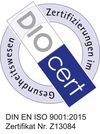Dysgnathic surgery
Malpositions of the jaws (dysgnathia) are deviations from the normal function and aesthetics of the face which can be well treated by orthodontia or surgery. In these cases, the position of the upper and lower jaws in relation to each other, the location of the jaws in relation to the base of the skull, and the positioning of the teeth are not correct. This often results in a disharmonic facial profile. These anomalies can lead to difficulties with chewing, swallowing, and speaking as well as temporomandibular joint pain and head and back pain. In addition, nasal breathing may be disturbed.
The operation takes place under general anesthesia and carries a very low risk. During surgery, the jaws are fixed in their planned new positions with mini titanium plates and titanium screws. These remain on the bone of the patient and are removed only if they lead to problems or become infected. If they cause no irritation, the plates are left in the body. All incisions during the operation are made inside the mouth. No exterior incisions are necessary.
Our patients receive interdisciplinary pre- and postoperative care from an orthodontist as well as other specialists, ensuring optimal care during the hospital stay. The UKE has all modern technical equipment required for your treatment – digital volume tomography, 3D photography, software for planning the operation with the option to simulate the surgical outcome, intraoperative navigation, microsurgery, and an ultra-modern operating theater. An intensive care unit and an intermediate intensive care unit are available around the clock.
Following an outpatient appointment or submission of medical findings, photos, and X-rays (e.g., on a CD), as well as dental jaw models, if available, the necessity of surgery is discussed. Patients usually have to remain in the hospital for 5-6 days. On the first day – provided that no additional examinations are required – the patient is briefed by the maxillofacial surgeon and the anesthesiologist and undergoes a physical exam as well as a blood draw. Surgery takes place on the second day. In the following days the patient recovers from surgery. Subsequently, a return to the home country is possible. After 3-4 weeks the orthodontist in the home country can begin the post-operative fine tuning during which he receives phone support from the UKE.
Please direct your treatment request to the UKE International Office.



